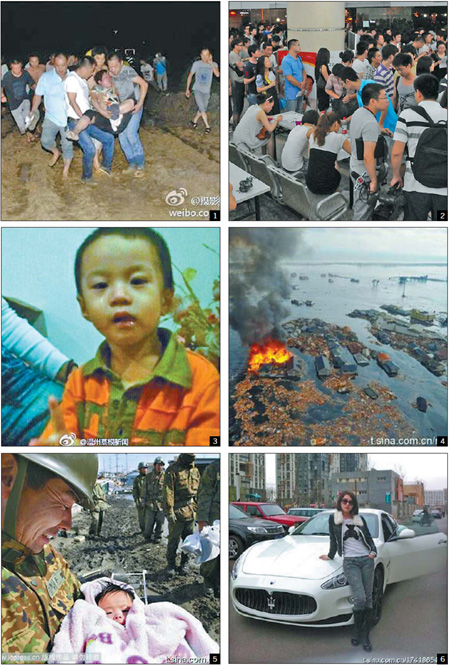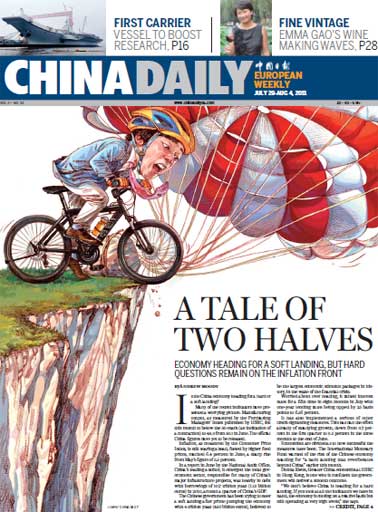Society
Micro blogs find their time is now
Updated: 2011-08-01 08:08
By Yu Ran (China Daily)
|
1. "Unity is strength." Retweeted 2,878 times, with 565 comments, within an hour of the train crash. 2. A netizen's photo of blood donors in Wenzhou. 3. "Looking for 4-year-old boy Jin Doudou . . .There isn't any clue about him. . . . Please forward this message and help to find him!" This plea came from an uncle. Doudou and his parents were found dead, the boy held tightly in dad's arms. 4."Tsunami drown many houses in Miyagiken, Japan. . . . Fires hit some areas." posted on March 11. 5. "A soldier of Japan Self-Defense Forces saves a 4-month-old baby girl" was forwarded 191 times. 6. "I got the 20th birthday gift in advance." The start of one of the posts by "Guo Meimei Baby" that purported a link to the Red Cross Society of China and set off a micro blog firestorm. Screen Captures from Sina Weibo |

Instant delivery provides cutting edge for weibo, Yu Ran reports in Shanghai.
"Our train bumped into something.Our carriage has fallen onto its side. Children are screaming . . . Come to help us please! Come fast!"
The words tweeted by a passenger on high-speed train D301 on July 23 were clearly a cry for help. But they also initiated a wave of unprecedented "citizen journalism" on China's Twitter-like micro blogs.
A university sophomore writing under the name Yangjuan Quanyang posted the message on Sina Weibo at 8:47 pm. The train she was on had just crashed into bullet train D3115 outside Wenzhou. Of her fellow passengers, 40 were killed and 190 injured. She survived.
In 10 hours, Yangjuan's plea was reposted 100,000 times. In the following week, there were 10 million messages about the crash on Sina Weibo and 20 million on QQ Weibo, the other major Chinese micro blog.
"Everyone could have been there on the train," bloggers said tens of thousands of times.
In the aftermath of the crash in East China's Zhejiang province, China's more than 20 million micro-bloggers demonstrated unfamiliar power: They broke the news, joined the rescue work, helped survivors and families of victims, and monitored the authorities who were investigating the accident.
Comments were highly emotional early on, and rumors abounded. But then some observers who communicate through micro blogs took on the mantle of the fourth estate and its tenet of monitoring the holders of power.
In this way, sociologists say, micro blogs provide a platform for Chinese to develop a mature citizenship, which is a prerequisite for China to steer toward a civil society.
During the two-year history of micro blogs in China, bloggers have claimed other successes. In March, they pushed a city government to not to cut down 600 old trees, and organized help for earthquake victims in Japan. In July, they put the Red Cross Society of China and its financial operations under public scrutiny.
A multi-use tool
When the train crash happened, micro blogs delivered the news quickly. It was the medium of opportunity or choice for passengers on the train, witnesses to the crash and reporters from traditional news outlets.
Wu Zhiyong, a senior journalist at Wenzhou City's Newspaper, was in the first group of newspeople who arrived at the accident scene. He posted photos and wrote about the rescue process, posting the information on his personal micro blog.
"As a journalist, I have the responsibility to spread the true side of news to the public immediately, and micro-blogging is the most convenient method for me," he said. He just uses his mobile phone.
Within four minutes after Yangjuan Quanyang's post went out, the staff at Sina Weibo set up a train crash page with related information, including search notices for missing passengers, numbers of the dead and the numbers and conditions of the injured.
"We have a 24-hour working team for the micro blog. The names of injured passengers sent to hospitals were updated regularly, which is much faster than the official figures released by authorized news agency and local government," said Mao Taotao, a public relations manager at Sina.
Micro blogs were effective in gathering help. Two hours after the accident, injured passengers were sent to hospitals and bloggers began posting messages calling for blood donations.
More than 1,000 people rushed to the donation center to give blood after midnight. A netizen's photo showing a crowd of people in a blood donation station was widely circulated, prompting more people to give help.
"I've never felt so proud of being a Wenzhou resident. We are all united as we do our best to help the injured and victims of the accident as fast as we can," read a message posted by Chen Zhao, a businessman who worked as a volunteer at the blood center.
Bloggers helped relatives and friends find information about train passengers, and they collected donations for the victims' families.
One example: Chen Lihao, a businessman in Zhuhai of South China's Guangdong province, promised to donate 1 yuan (16 cents) to Xiang Weiyi, a 2-year-old who was the last passenger to be rescued, every time his message praying for her health was reposted.
His message was tweeted 900,000 times within one day, and Chen immediately wired more than 1 million yuan ($155,300) to the girl's family.
The government also used micro blogs to respond. For example, 24 hours after the crash, Zhejiang provincial health department tweeted that the blood supply in Wenzhou had reached sufficient levels to help the injured.
Bloggers also kept their eyes on the authorities. They checked efforts to rescue passengers from the trains, and questioned whether the work ended too soon. They monitored those investigating the cause of the accident, and wondered in the tweets whether railway authorities were hiding key evidence.
Public opinion
The attention given the train crash is unprecedented because every citizen is an interested party in a country where trains dominate long-distance transportation, said Gu Xiaoming, sociology professor at Fudan University in Shanghai.
Like traditional news media, he said, micro blogs function as a magnifier for the public to see the details of problems and to spur discussions. But unlike traditional media, everyone on the street can take a photo, record a video clip and write a quick note about what is happening.
About the train crash, Gu said, millions of "citizen journalists" agree with each other about helping the victims and requesting the truth, and thus they become a combined force of public opinion.
Much information spread in micro blogs turned out to be rumors. One said a Japanese television host smiled while reporting the story. Another said only reporters wearing certain caps were allowed to raise questions during Premier Wen Jiabao's news conference at the crash site on Thursday.
But these rumors died fast. "When there is a conflict of information, the true information and reasonable points of view are more persuasive and easier to be accepted by the public," Gu said.
The Internet, along with the public opinion that comes through it, has the ability to "clean itself", said Zhu Chunyang, a journalism professor at Fudan University.
"Rumors, which often come with strong emotions on micro blogs, seem to have a negative effect on social stability, but they actually show the desire of the public to know the truth concerning everybody's daily life," he said.
"To fight rumors on micro blogs, government had better make right decisions and transparent responses in time. In this way, micro blogs as a platform not only train the public in expressing their opinion but also train the government in facing the opinion."
Xu Junqian contributed to this report.
(China Daily 08/01/2011 page1)
E-paper

Double vision
Prosperous Hangzhou banks on creative energies to bridge traditional and modern sectors
Minding matters
A touch of glass
No longer going by the book
Specials

Carrier set for maiden voyage
China is refitting an obsolete aircraft carrier bought from Ukraine for research and training purposes.

Pulling heart strings
The 5,000-year-old guqin holds a special place for both european and Chinese music lovers

Fit to a tea
Sixth-generation member of tea family brews up new ideas to modernize a time-honored business

